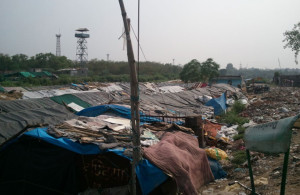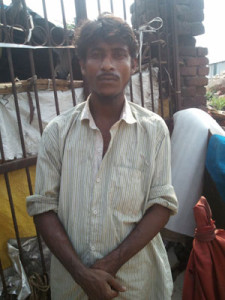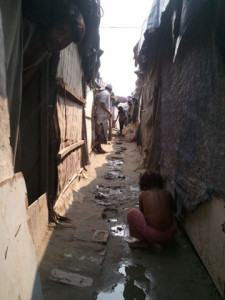Rohingya Refugees in India: Tales of Endless Persecution, Torture and Exploitation
ASIA--PACIFIC, 15 Jul 2013
Shivnaryan Rajpurohit – Counter Currents
 Another World Refugee Day on June 20 was met with familiar indifference by host countries. Every year, it is passed off as a necessary irritant when media air and publish stories on refugees.
Another World Refugee Day on June 20 was met with familiar indifference by host countries. Every year, it is passed off as a necessary irritant when media air and publish stories on refugees.
Well, this is another sordid tale of Rohingya refugees–who fled Myanmar–in India, sheltering around 11,000 Myanmarese refugees (a figure obtained from the UNHCR). In June and October 2012, Indian cities– Jammu, Delhi, and Hyderabad– and the state of Mizoram saw the influx of Rohingya Muslims. The trickle still continues.
In Madanapur Kahdar locality of Delhi, around 200 Rohingyas, tortured and persecuted by military junta and Buddhists, reside in a makeshift camp. They escaped death and violence in Rakhine State, western coast of Myanmar. In the camp each family has lost at least one person during anti-Muslim riots in Rakhine.
The low-lying Rhohingya camp– owned by the Zakat Foundation India which helped them last year when they protested outside the UNHCR office for their refugee status– is approached by dusty lanes. Surrounded by drainage and mounds of boulders, the camp is no less squalid than that of Haiti or Kenya. Propped by bamboos and covered by tarpaulin sheets, every room is wobbly. Thatched roofs are paper-weighted by big boulders. During early monsoon showers when Delhi revelled the Rohingyas bucketed out water from the narrow passages of the camp.
Dreary eyes and dropped shoulders of Rohingyas are telltale signs of their hardship in India. This stateless minority–since they are not recognised in the land of Aung Saan Suu Kyi– has been exploited not only in Myanmar but also in Bangladesh which has recently said that it could not accommodate more people.
Fighting his tears, differently-abled Abdul Karim, 28, recounts horrific tales of genocide unleashed in Myanmar. Born to Myanmarese parents in India, Abdul has been living in India for 28 years, but no citizenship for him: he does not have birth certificate to prove because he was born in an Indian jungle when his parents crossed over to India. Still coming to terms with what happened to his parents–hacked to death by military junta on their return journey in Myanmar–distraught Karim relives his gory past every day.
“Nobody owns us,” he says on his stateless status
“Every time we cross the border we have to pay the price in the form of money or woman to the army, stationed at borders. We do not have any protection. We are born to tolerate everything silently,” he adds.
“Recognition is the main thing. Our cries are listened but not acted upon. We are born to see bloodletting. Now we have resigned ourselves to torture and persecution,” he says as his eyes well up.
After finding shelter in the camp, Abdul started working in a tin factory which paid him partially after one month. “The owner gives me the slip whenever I visit the factory,” he bemoans. Now he runs a shop in the settlement.
The most vulnerable sections of the society during riots and bloodletting are women and children. None of the children goes to school. Fully aware of the role played by education , Abdul Kayoom repents,“Today I am a hawker because I was not allowed to study in my country. I do not want same thing to happen to my children.” “In India we are at least safe and can practice our religion,” he adds.
In addition to that, the camp houses around 10 destitute widows who are ragpickers. One of them is a mother of one. Clad in a ragged vermillion T-shirt and loosely-draped sari,Samjida Begum, aged 20, lost her husband last year during the riots in Myanmar. She thereafter fled her country and came to India by illegally crossing the Indo-Bangladesh border. She is a ragpicker now, earning Rs 60-70 a day. Having learnt from her harrowing stay in Myanmar, She is firm to have her baby educated and be brought up in a peaceful environment. “I want to educate her so that she should have a good life,” she pledges.
Most of the refugees work as daily-wage labourers, rickshaw pullers, factory workers, and vegetable hawkers.
Out of 5o families around 40 have so far received temporary refugee cards from the UNHCR which provides them with subsistence allowance of Rs 1000 to each employed family. However, this allowance has not touched destitutes, like Samjida Begum, and handicapped.
But the UNHCR, which has the mandate over 24000 refugees of various nationalities in India, differs on discriminating against anyone. In an emailed reply, it says that the Rohingyas have been treated at par with that of other countries. It assures that it can do more but resources crunch has pushed them backwards on crucial issues
Everyone in the camp calls themselves refugees rather than migrants because they fled to India not on their own volition but due to anti-Muslim violence in Arakan state. They feared persecution and torture. Moreover their property had been appropriated by the government and Buddhist hooligans in Myanmar.
“We had enough to eat and lived happily in our village, but Buddhists looted everything. We were intimidated there,” Mohammad Haroon laments, another refugee who escaped from the wanton killing of Muslims in northern Rakhine State of Myanmar.
When asked about their voluntary repatriation if Aung Saan Suu Kyi comes to power, they raise their decibel and accuse Suu Kyi of failing them.
On their expectations from the UNHCR and the government of India, they contend that it has been satisfactory. They meekly criticise the government of India and are appalled by government’s indifference. “For the past one-and-a-half year, nobody from the government has visited us,” says Mohammad Haroon.
However the UNHCR hails India in some regards. It says, “Overall, India offers safe asylum to refugees and asylum seekers. Despite the absence of a national legal framework for refugees, India has traditionally been hospitable towards refugees.”
If seen in the context of the arrival of some Hindus from Pakistan it becomes clear that the criterion vary as how to treat asylum-seekers and refugees. Hindu refugees from Pakistan have afforded an opportunity to our politicians to score brownie points. In Rajasthan, the state government met all of them and paid heed to their sufferings. The RSS and VHP hijacked this issue and shed brotherly tears for the Hindus. It highlights that our response to refugees is shaped by religion and ethnicities– an abominable practice which thrives on adhocism
Though India has done next to nothing to Rohingyas but the principle of non-refoulement has been complied with by India as none of the refugees has been forcefully repatriated.
Now it seems that refugees’ not-so-troubled stay may face aberration once again
Zakat Foundation which temporary rehabilitated the Rohingyas on the current location says that this land was granted for an orphanage. “After securing procedural documents, we will start building the orphanage. It might take around two months,” says Mumtaz Nazmi, secretary of Zakat Foundation.
“It’s the turn of the government of India to bail them out,” he asserts
Nobody knows what is in store for the Rohingyas once the Foundation starts removing them to build an orphanage. Their trepidation is palpable as they know sooner or later they will have to vacate the place for orphanage.
In broad strokes India’s laxity to frame a refugee law is the culprit. It has been belaboured by intellectuals. They have asked India to sign the Refugee Convention 1951 and Protocol 1967, and to promulgate a legal framework for refugees. Despite these urges, the cavalier attitude of the government has not caved in.
However, judicial intervention in this regard comes as a breath of fresh air. The Supreme Court has declared that Article 21 and Article 14, among other constitutional rights, are applicable to everyone residing in India. Judicial intervention notwithstanding, government’s intransigence to frame a law is inexplicable. It is need of the hour to pass a law when forced displacement has reached its peak in 18 years.
By framing a law, India will not only help itself but thousands of refugees from Afghanistan, Sri Lanka, Pakistan, Bangladesh, Myanmar and Bhutan.
______________________
Shivnaryan Rajpurohit is from Bikaner, Rajasthan and a graduate of the Asian College of Journalism, Chennai. He blogs at akpushpa@wordpress.com.
Go to Original – countercurrents.org
DISCLAIMER: The statements, views and opinions expressed in pieces republished here are solely those of the authors and do not necessarily represent those of TMS. In accordance with title 17 U.S.C. section 107, this material is distributed without profit to those who have expressed a prior interest in receiving the included information for research and educational purposes. TMS has no affiliation whatsoever with the originator of this article nor is TMS endorsed or sponsored by the originator. “GO TO ORIGINAL” links are provided as a convenience to our readers and allow for verification of authenticity. However, as originating pages are often updated by their originating host sites, the versions posted may not match the versions our readers view when clicking the “GO TO ORIGINAL” links. This site contains copyrighted material the use of which has not always been specifically authorized by the copyright owner. We are making such material available in our efforts to advance understanding of environmental, political, human rights, economic, democracy, scientific, and social justice issues, etc. We believe this constitutes a ‘fair use’ of any such copyrighted material as provided for in section 107 of the US Copyright Law. In accordance with Title 17 U.S.C. Section 107, the material on this site is distributed without profit to those who have expressed a prior interest in receiving the included information for research and educational purposes. For more information go to: http://www.law.cornell.edu/uscode/17/107.shtml. If you wish to use copyrighted material from this site for purposes of your own that go beyond ‘fair use’, you must obtain permission from the copyright owner.

